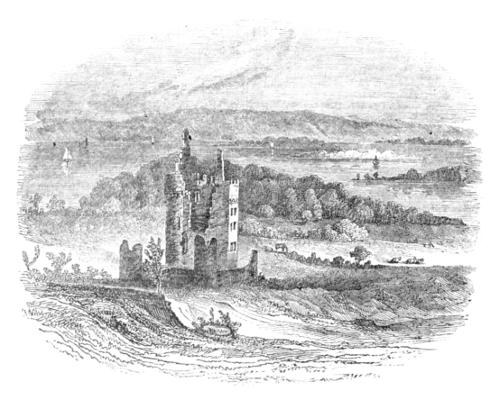THE IRISH PENNY JOURNAL.
| Number 26. | SATURDAY, DECEMBER 26, 1840. | Volume I. |

THE CASTLE OF TERMON MAGRATH, COUNTY OF DONEGAL.
In a recent number of our journal we called the attention ofour readers to the little-appreciated beauties of Lough Erne;and we now present them with another vista of that delightfullocality in connection with the Castle of Termon Magrath, orTermon, as it is more usually called, which is situated at itsnorthern extremity, in the county of Donegal. Considered asa sheet of water, the lower lake appears from this side to thegreatest advantage; but its distant shores are but little improvedby plantations, and consequently look comparativelybleak and barren. In the immediate vicinity of our subject,however, the scenery is of the rich character for which LoughErne is so remarkable, the shores of the lake being fringedwith the plantations of the glebe of Templecarn and those ofWaterfoot, the beautiful seat of Colonel Barton.
The Castle of Termon is situated in the parish of Templecarn,about half a mile to the west of the pleasant and improvinglittle town of Pettigoe, which, if it had a comfortableinn, would be a good station for pleasure tourists wishing toenjoy the scenery of the lower Lough Erne and that of LoughDerg, with its celebrated purgatory of St Patrick.
The foundation of this castle, according to popular tradition,is ascribed to the celebrated Malmurry, or, as he wasusually called, Myler Magrath, the first Protestant Bishop ofClogher; and there is every reason to believe this traditioncorrect. The lands on which the castle is situated ancientlyconstituted the Termon of St Daveog of Lough Derg, of whichthe Magraths were hereditarily the termoners or churchwardens;and of this family Myler Magrath was the head; so thatthese lands properly belonged to him anteriorly to any grant ofthem derived through his bishopric. He was originally aFranciscan friar, and being a man of distinguished abilities,was advanced by Pope Pius V. to the see of Down; but havingafterwards embraced Protestantism, he was placed in thesee of Clogher by letter of Queen Elizabeth, dated 18th May1570, and by grant dated the 18th September, in the sameyear. He remained, however, but a short time in this see, inwhich he received but little or nothing of the revenues, and inwhich he was probably surrounded by enemies even amonghis own kindred, and was translated to the archbishopric ofCashel on the 3d of February, in the year following. He diedat Cashel at the age of one hundred, in the year 1622, andwas interred in the choir of that ancient cathedral, where asplendid monument to his memory still exists, with a Latininscription penned by himself, of which the following quainttranslation is given in Harris’s Ware:—